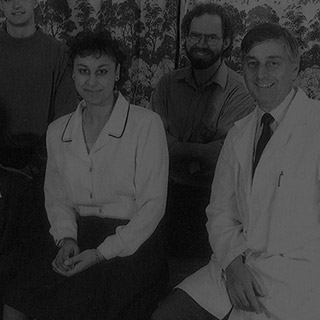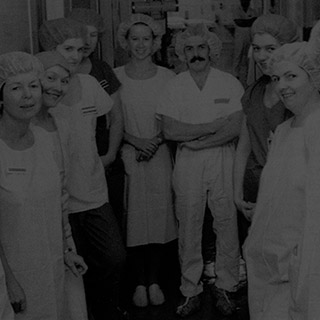Meron Pitcher
General surgeon, breast cancer clinic pioneer Footscray Hospital 1993–present
Meron Pitcher was born in Melbourne. She was educated at Methodist Ladies’ College in Kew and graduated from Melbourne University’s medical school. Dr Pitcher completed her surgical training overseas at British hospitals before returning to Melbourne in 1993 to take up a position at Footscray Hospital.
Arriving at Footscray
“I was appointed as a senior lecturer in the department of surgery when it was set up by the inaugural Professor of Surgery, Bob Thomas. I was also lucky enough to be attached to Trevor Jones’ surgical unit. Trevor had taught me when I was a medical student at the Austin and the Heidelberg Repatriation Hospital.
I spent about half my time doing clinical work – a few operating lists, an endoscopy list and outpatients’ clinics – and the other teaching undergraduate medical students and doing some private consulting.”
The importance of a mentor
“Trevor Jones was a great mentor and teacher, during my years as a medical student and later as a surgeon. Although he was exceptionally busy, he was one of the people that we, as students, really appreciated because he was very clear in terms of his expectations and he was always very passionate about patient outcomes and about common sense.
He always deeply cared about what happened to his patients. He was interested in the patient as a person –where they come from, what they do for a living and what makes them tick.
If a patient was from a small village in Poland, he would take the time to learn about where that patient was from and he would make the effort to learn a few words in Polish. Patients trusted Trevor because they liked him and they knew he genuinely cared about what happened to them. That was the same for his medical students. He was genuinely interested in his students and he wanted to hear their story.
There’s a funny story, which highlights the lengths Trevor will go to, to learn about others. Trevor likes to think he is good with other languages. We had a Vietnamese intern and on the first day, Trevor said to him, in Vietnamese, what he thought was “Good morning doctor.”
This poor boy looked at Trevor very confused and then all of a sudden burst out laughing when he realised what Trevor had tried to say to him. Instead of “Good morning doctor,” Trevor had said “A bowl of porridge.” That’s Trevor, he was trying to connect with someone and although it wasn’t what he had intended to say, it certainly provided us with a few laughs.
Trevor’s commitment to the public healthcare system has been outstanding. For me, that’s the thing that is different about Trevor, he has dedicated himself to the public system.
As a young registrar I remember trying to find cases that would trouble Trevor, or make him sweat a little, because he was always so cool, calm and collected. When Trevor was in charge, everything seemed to run so smoothly.
He was a phenomenal role model. He always knew what a great privilege it was to teach and mentor students.”
Establishing the breast cancer clinic
“Mary Stannard was the medical director and she said I should go to Sunshine Hospital and set up a clinic for women with breast problems. I suspect it suited her in the overall grand plan of turning Sunshine from being an obstetrics hospital into a place with more general surgery input. I set up the clinic in 1994. At about the same time several things happened that led to an increase in the number of patients wanting to see a breast specialist.
The government had funded a statewide roll out of breast screening, after data showed breast screening was saving the lives of women with breast cancer.
There was a trend towards specialisation in medicine and public attitudes were changing, with more people wanting to see someone expert in a particular area.
Treatment for cancer was also changing – new chemotherapy treatments were being used and there was much less use of mastectomy to treat breast cancer.
Most of the older general surgeons who had been managing women with breast cancer continued to see their patients in their clinics, but most of them were quite happy for someone to take on the new patients because the treatments were changing.
I ran the afternoon clinic by myself with a registrar. We didn’t have any nursing support – no one to help you with dressings, to help with procedures, to break bad news to patients.
We had very limited access to clinic nurses.
That’s just the way it was. The hospital never had spare money for anything. My attitude was you just got on and did the work. There wasn’t any point asking for anything because you didn’t expect to get anything.
But then Tony Hyatt was appointed to the staff and he came to the clinic and was horrified that I was running the clinic without nursing support. Sometimes you need someone to come in with fresh eyes and tell you that something is ridiculous.
Liz Edmonds, the clinical services director, managed to get some funding for a breast care nurse for the clinic. Liz suggested we get help from consumers to get some funding, which we did.”
Ditching tradition
“From early on, we wanted it to be a truly multi-disciplinary clinic with both surgeons and medical oncologists and breast care nurses in the same place at the same time.
In the past, the treatment administered to a patient would be done by one specialist – one person would be in charge and they would direct all of the patient’s treatment. In the case of breast cancer, the surgeon would decide whether or not they ought to go and have a conversation with a medical oncologist to talk about treatments.
Whereas today we have a weekly meeting with all the specialists - radiotherapists, oncologists, pathologists, radiologists, breast care nurses, the surgeons, plastic surgeons and others. This is the way we manage most cancer patients today. All of the patient information is reviewed and a discussion takes place about the treatment options and recommendations. So we can hopefully provide best practice to people.”
Footscray’s character
“We have a flatter, collaborative management structure in this hospital compared with most other Melbourne hospitals. The people who work here and stay here are here because they see that the needs of people in the west are so great.
The deprivation in the west is significantly worse than any other area of Melbourne. It means you can make quite a lot of difference by doing whatever you can to help people. Our patients are a really interesting group of people, they come from a wide variety of backgrounds and the need is greater. That’s what makes the work so rewarding.”
BreastWest – community support at its best
“BreastWest is unique in Melbourne in terms of the practical support it provides for breast cancer patients at our hospital. It was started more than 10 years ago by Claire Culley, the divisional director of surgery, who could see there weren’t a lot of practical supports available for women with breast cancer – things like wigs, cosmetics and creams, help with house cleaning or getting to appointments.
It’s been phenomenal in raising community funding, other than what’s in hospital budgets, to make a difference to patient’s lives. We feel enormously supported by the community through BreastWest’s work.”

